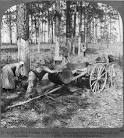Tar Heel Nation
In honor of my new home, North Carolina, I decided to dig into why the state is known as  the “Tar Heel” state. I had heard a story years ago, something about slaves delivering tar from the many pine trees in the eastern part of the state on their backs to the ships bound for England, and the tar dripping from the containers left behind their footprints on the boardwalks in front of the ships. That notion is only one of the stories around the name, as I quickly discovered when I started investigating.
the “Tar Heel” state. I had heard a story years ago, something about slaves delivering tar from the many pine trees in the eastern part of the state on their backs to the ships bound for England, and the tar dripping from the containers left behind their footprints on the boardwalks in front of the ships. That notion is only one of the stories around the name, as I quickly discovered when I started investigating.
One version of the story places its origins at the time of the Revolutionary War, when General Cornwallis invaded the state with his British troops. As they marched through a river in the eastern part of the state, they slogged through a bed of tar, placed in the river by North Carolina soldiers to slow down the march. Not only did the soldiers exit the river with tar on their highly polished boots, but their tar-heeled footprints left tracks that could be easily followed by the American soldiers.
The modern term probably began in the 1800s, and was then known as “rosin heels,” so named to describe the lower class of workers, who got their hands and bodies dirty from their labor. “Rosin heels” refers to the rosin from the abundant pine trees in the area. Rosin was used in the making of turpentine, and it dripped from the bark of the trees, if they were scored with axes, or entire forests of pine were cut and burned to form the rosin. Then, each collection point had to be cleared out with a paddle transferring the rosin into a barrel. It was tedious and messy work in the hot and humid summer months and the workers typically went barefoot. Imagine the tar footprints left behind at these pine fields.


Another version of the story places the time line during the Civil War. When the going got tough, some of the soldiers threatened to retreat from battle. The North Carolina contingent threatened to put tar on the heels of the reluctant soldiers to keep them in the battle. It was noted the North Carolina boys stuck to their jobs as if they had tar on their heels. General Robert E. Lee was said to have commented, “God bless the Tar Heel boys!”

Tar, pitch and turpentine from the pine trees were major resources exported by the North Carolina colony for the British navy. Tar and pitch were used to coat the bottom of the wooden ships to make them watertight. At its peak, nearly 100,000 barrels of tar and pitch were sent annually to England.
This early meaning of the word underwent a change during the Civil War. Its derogatory beginnings morphed into an accolade. North Carolina soldiers called themselves “Tar Heels” as a matter of state pride. It’s now even the official nickname of UNC sports teams.
http://muse.jhu.edu/article/608417
https://alumni.unc.edu/what-is-a-tar-heel/
http://www.unc.edu/about/history-and-traditions/whats-a-tar-heel/
https://en.wikipedia.org/wiki/Tar_Heel
Thank you for doing the research, Becky! I have always wondered about the name and your findings confirm what I have long suspected. Rosin related production is referred to as naval stores, which makes sense considering the original use for pine tar. I know you will enjoy your new home in the beautiful Tar Heel state!
LikeLiked by 1 person
Great share about a well-known nickname!
LikeLiked by 1 person
I love finding out the reasons behind things, and I figured this one had a great story or two behind it.
LikeLike
That’s pretty neat. I’ve never heard of Tar Heel before. 👍🏼
LikeLiked by 1 person
As an American expat, native North Carolinian and lover of history, i enjoyed this informative post. Since i often ran around outside barefoot as a child, i can attest to the tar-like nature of pine rosin!
LikeLiked by 1 person
Your comment made me smile, Henry. Glad you enjoyed the post.
LikeLike